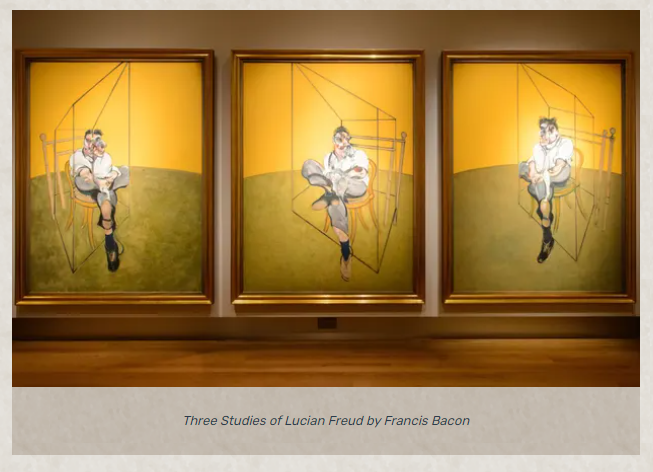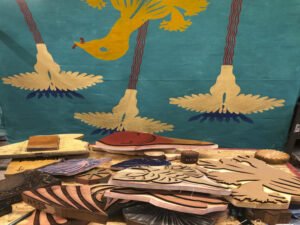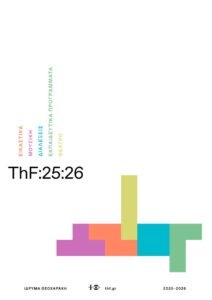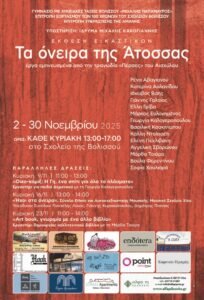FRANCIS BACON’S NEVER EXHIBITED FIRST SCREAMING POPE ON SHOW AT LONDON’S GAGOSIAN GALLERY
#FrancisBacon

By Deepan Joshi
British painter Francis Bacon’s first image of a screaming Pope—never exhibited publicly—is due to go on show next week at Gagosian gallery in London. The papal image, known as Landscape with Pope/Dictator, will be displayed at Davies Street gallery in Mayfair from 15 March to 23 April.
The work, made in Monaco in 1946, depicts a figure in a traditional Catholic clergy cap and a shirt and tie, combining religious elements and sinister aspects from the artist’s fascination with Fascist dictators.
On 19 October 1946, Bacon wrote to Duncan MacDonald, a director of the Lefevre Gallery in London: “I am working on three studies of Velázquez’s portrait of Innocent II [sic]. I have almost finished one. I find them exciting to do.” Bacon was fascinated by Velázquez, the leading 17th-century artist in the court of King Philip IV of Spain.
According to the Sunday Times, the work was discovered by Martin Harrison as he compiled Bacon’s catalogue raisonné in 2016. Gagosian gallery says that Landscape with Pope/Dictator is not for sale.
Bacon’s inspirations and discoveries
The best commentaries on Bacon’s work are by Bacon himself in two series of interviews: with David Sylvester between 1962 and published in the later year, and with Michael Archimbaud between October 1991 and April 1992. In both he speaks admiringly of Picasso, especially of the 1926-1932 period, the only one to which he feels truly close; he saw “an area there… which in a way has been unexplored, of organic form that relates to the human image but is a complete distortion of it.” With this very precise remark, he defines the realm whose exploration is actually his alone.
Bacon never worked with the subject of the portrait sitting in his studio and he rarely painted strangers. He was fascinated by photography and by X-rays. “I’ve had photographs taken for portraits because I very much prefer working from the photographs than from models… I couldn’t attempt to do a portrait from photographs of somebody I didn’t know…” What is Bacon trying to tell us, what is he doing, and how is he able to achieve that. He gives another clue, “If my people look as if they’re in a dreadful fix, it’s because I can’t get them out of a technical dilemma.” He can’t paint strangers, he can do self-portraits and portraits of his friends or those he regularly drinks with. In the broader sense he says about his art, “I would like my pictures to look as if a human being had passed between them, like a snail leaving its trail of the human presence… as a snail leaves its slime.” He paints people he knows as he understands them as human beings, so even if the brutal hand of the painter botches up the face the diamond lying underneath is still recognisable, the precious nugget, the self of the subject.
The Franco-Czech novelist Milan Kundera said while talking about Bacon’s portraits: “Looking at Bacon’s portraits, I am amazed that, despite their ‘distortion’, they all look like their subject. But how can an image look like a subject of which it is consciously, programmatically, a distortion? And yet it does look like the subject; photos of the persons portrayed bear that out; and even if I did not know those photos, it is clear that in all the triptychs, the various deformations of the face resemble one another, so that one recognises in them the same person. However ‘distorted’, these portraits are faithful. That is what I find miraculous.”
The former British Prime Minister Margaret Thatcher once called him “that man who paints those dreadful pictures.” But Bacon maintained that he was simply a realist and did not aim to shock. “You can’t be more horrific than life itself,” he was fond of saying.
.“In painting, we always leave in too much that is habit, we never eliminate enough…’ . Too much that is habit, which is to say: everything in painting that is not the painter’s own discovery, his fresh contribution, his originality; everything that is inherited, routine, fill up, elaboration considered to be technical necessity. Almost all great modern artists mean to do away with ‘filler’, do away with whatever comes from habit, from technical routine, whatever keeps them from getting directly and exclusively at the essential (the essential: the thing the artist himself, and only he, is able to say).”
So it is with Bacon: the backgrounds of his paintings are super-simple, flat colour; but: in the foreground, the bodies are treated with the richness of colours and form that is all the denser. Now, that (Shakespearean) richness is what matters to him. For without that richness (richness contrasting with the flat colour background), the beauty would be ascetic, as if ‘put on a diet’, as if diminished, and for Bacon the issue always and above all is beauty, the explosion of beauty, because even if the word seems nowadays to be hackneyed, out of date, it is what links him to Shakespeare.
And that is why he is irritated by the word ‘horror’ that is persistently applied to his painting. Tolstoy said to Leonid Andreyev and of his tales of terror: ‘He is trying to frighten me, but I’m not scared’. Nowadays there are too many paintings trying to frighten us, and they annoy us instead. Terror is not an aesthetic sensation, and the horror found in Tolstoy’s novels is never there to frighten us; the harrowing scene in which they operate on the mortally wounded Andrei Bolkonsky without anaesthesia is not lacking in beauty; as no scene in Shakespeare lacks it; as no picture by Bacon lacks it. Butcher shops are horrible, but speaking of them, Bacon does not neglect to remark that, “for a painter, there is this great beauty of the colour of meat.”
When Archimbaud asks Bacon which contemporary artists are important to him, he says: “After Picasso I don’t really know. There’s an exhibition of pop art at the Royal academy at the moment… [But] when you see all those pictures collected together, you do not see anything. To me there is nothing in it, it’s empty, completely empty’. And Warhol. He isn’t important to me.’ And abstract art? Oh no, he doesn’t like it.
Bacon commands a very high price. His Three Studies of Lucian Freud sold at Christie’s New York in 2013 for $142.4 million—the highest auction prize of a work of art at that time. Bacon, a devout atheist, made more than 40 portraits of popes over a 20-year period.
That is why even the great subject of the Crucifixion, which in past times concentrated within itself the whole ethics, the whole religion, indeed the whole history of the West, becomes in Bacon’s hands a mere physiological scandal. “I’ve always been very moved by pictures about slaughterhouses and meat, and to me they belong very much to the whole thing of the crucifixion. There’ve been extraordinary photographs of animals just being taken up before they were slaughtered; and the smell of death…’
To link Jesus nailed to the cross with slaughterhouses and an animal’s fear might seem sacrilegious. But Bacon is a non-believer, and the notion of sacrilege has no place in his way of thinking; according to him, “Man now realises that he is an accident, that he is a completely futile being, that he has to play out the game without reason.” Seen from the angle, Jesus is that accident who, without reason, played out the game. The cross: the final point of the game played out to the end without reason.
No, not sacrilege; rather a clearsighted, sorrowing, thoughtful gaze that tries to penetrate to the essential. And what essential thing is revealed when all the social dreams have evaporated and man sees “religious possibilities… completely cancelled out for him”? The body. Only ecce homo, visible, touching, concrete. For “Certainly we are meat, we are potential carcasses. If I go into a butcher’s shop I always think it’s surprising that I wasn’t there instead of the animal.”
This is neither pessimism nor despair, it is only obvious fact, but a fact that is veiled by our membership in a collectivity that blinds us with its dreams, its excitements, its projects, its illusions, its struggles, its causes, its religions, its ideologies, its passions. And then one day the veil falls and we are left stranded with the body, at the mercy of the body.
Sources: Encounter by Milan Kundera and Interviews with Francis Bacon by David Sylvester
#FrancisBacon
17–19 Davies Street
London w1k 3de
+44 20 7493 3020
london@gagosian.com
Hours: Tuesday–Saturday 10–6




